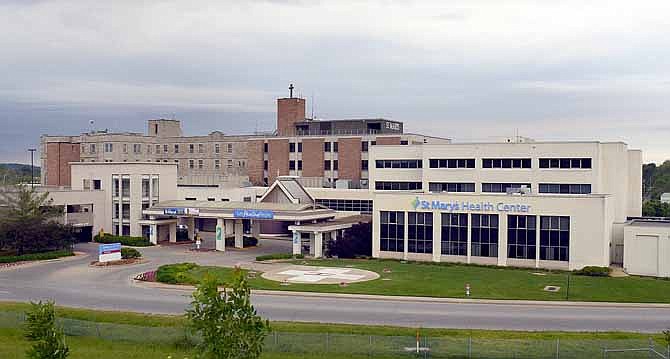Capital Region Medical Center and St. Mary's Health Center will lose millions of dollars over the next few years because of various federal payment cuts, officials with the two Jefferson City hospitals have said.
"Sequestration, which affected defense and a lot of the federal government agencies or departments, affects hospitals, too," said Ed Farnsworth, president of CRMC. "There's lots of cuts in our patient reimbursement, our inpatient reimbursement, DSH (disproportionate share hospital) payments, Medicare and Medicaid."
The average annual reduction in federal payments to SMHC is expected to be $5 million and even more than that to CRMC.
Experts describe sequestration, or the sequester, as a combination of expiring Bush-era tax cuts and automatic, across-the-board spending cuts that are the result of prior failures of Congress and President Obama to make a budget deal.
Beginning April 1, sequestration cut Medicare provider and insurer payments to hospitals by two percent.
"It just adds to the problem that we have," Farnsworth said.
Dave Dillon, vice president of media relations with the Missouri Hospital Association (MHA), said the agency estimates Affordable Care Act (ACA) reductions through Medicare, Medicaid and cuts through sequestration to total more than $153 million in 2013 and $345 million in 2014 in Missouri.
In 2010, President Obama signed the ACA, a law that includes comprehensive health insurance reforms that will roll out over the next few years. For 2014, the law gives states the option of expanding Medicaid to up to 138 percent of the federal poverty level, with full federal funding for the first three years and at least 90 percent funding the following years.
Dillon said the reality is that Medicaid expansion through the ACA was intended to offset some of the federal cuts through both Medicare and Medicaid. Expansion would have lessened uncompensated care for Missouri hospitals.
"But when the Supreme Court decided that states didn't have to expand Medicaid, it endangered that balance that was envisioned in the Affordable Care Act," Dillon said.
Missouri legislators decided not to expand Medicaid during this year's legislative session, which ended May 17.
Dillon said Missouri hospitals are going to have to get creative in terms of finding ways to make up for the cuts.
"In 2011, uncompensated care costs that were provided by hospitals were over $1 billion," he said. "So, on top of the cuts that are included in the ACA, we're looking at an existing $1 billion hole to take care of the uninsured."
He said without the additional coverage included in the ACA, the MHA expects uncompensated care costs to continue to rise.
"It is a tremendous problem that the hospital community doesn't have an easy solution to," Dillon said.
Farnsworth and Brent VanConia, president of SMHC, both said their respective hospitals are seeing declines in volume, the number of patients visiting the hospitals for care.
The presidents said declining volume makes it easier to reduce expenses and try to make up for the federal cuts. But, declining volume means less revenue.
"When your volume goes down, then you need a few less employees, and you need less supplies and less medical things," Farnsworth said. "Your cost goes down a bit if you have less volume."
CRMC hasn't eliminated many staff positions, Farnsworth said. But they have cut staff through attrition.
"Plus, a lot of people who were working overtime are now working very little overtime," he said. "Our part-time people are working fewer hours.
"We definitely have fewer hours worked at the hospital than we did a year ago."
It's no different at SMHC.
"Folks are changing their purchasing behaviors, which is affecting utilization and the number of beds, the number of X-rays, lab tests and other things," VanConia said. "We're always managing volume, flexing staff appropriately based upon utilization."
He said the reductions in federal payments will have no impact on the construction of the new St. Mary's Health Center on Mission Drive. The new $200 million hospital complex will open by January 2015.
"We're past the point of this impacting the design or schedule for construction for the new hospital," VanConia said. "If we were designing it today or if we hadn't started construction, there might have been an impact."
The federal reductions also aren't impacting CRMC's ability to expand its facility.
Hospital officials announced Friday a $35 million expansion of its current hospital at 1125 Madison St.
The expansion will include additional rooms for ambulatory and outpatient services, as well as two floors of physician offices.
Farnsworth expects ground to be broken for construction in the fall and the expanded facility to open in spring 2015.
He said the expansion is CRMC reacting to the future of health care.
"Outpatient is being emphasized and really is where most patients should get care," he said. "For patients, it's less expensive and less disruptive.
"This project will really enhance our care."
He said that although some staff and overtime and part time hours have been cut because of the federal payment reductions, the facility's expansion includes adding 30-35 additional physicians, increasing hospital staff by nearly 100 employees.
"This is 100 more jobs than we would have had otherwise," Farnsworth said. "This is just something we had to do to allow care in the most appropriate setting."
VanConia said SMHC will be much more aggressive in looking to grow volumes. One of the hospital's big initiatives is to prevent patients from going to hospitals in Columbia or other facilities for their care.
"We'll be looking to increase our overall market share for inpatient and outpatient services," VanConia said. "We're also looking to expand our footprint beyond just our current primary service area, which is the four counties principally around Cole County."
He said SSM Health Care's purchasing of Mexico's Audrain Medical Center and its nine MedChoice rural clinics and SSM's creation of a Mid-Missouri Region expands SMHC's population base from 250,000 to nearly 400,000 people, helping grow volume.
"We believe there's considerable synergy and strategic positioning associated with expanding along the Highway 54 corridor," VanConia said.
Both Farnsworth and VanConia reiterated that Medicaid expansion in Missouri would be part of the solution to the federal payment cuts.
"It (expansion) helps our economy, helps patients get health care and adds jobs in our state," Farnsworth said. "If we don't do it, other states will continue their programs and our federal tax dollars from Missouri will go to other states.
"I personally don't like that very much."


